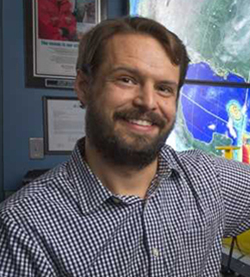Hurricanes and Robots
How new technology is changing the way we study and predict extreme storms.
Hurricanes are one of the deadliest and costliest natural disasters in the world. Our ability to predict where storms will make landfall has improved steadily, but it is still a challenge to predict a storm's intensity or strength. Robots patrolling our coastal oceans are providing new opportunities to improve hurricane intensity forecasts and inform better response plans. In this presentation you’ll learn how these heroic robots swim and survive into the eye of the storm to keep us safe.

Dr. Travis Miles
At the time of this broadcast Dr. Travis Miles was an Assistant Professor in the Department of Marine and Coastal Sciences at Rutgers University, New Brunswick, where he also received his Doctorate. He was a Fulbright Scholar at the University of Gothenburg, in Sweden and the recipient of the 2018 Marine Technology Society Young Professional Award. As a core faculty member in the Rutgers University Center for Ocean Observing Leadership (RUCOOL) he specialized in using networked ocean observing systems including autonomous underwater robots, remote sensing technologies, and predictive ocean and atmosphere models, to study air-sea interactions in storms. A large focus of his research has included improving hurricane intensity forecasts in the hours before they make landfall.
Education Resources:
Integrated Ocean Observing System (IOOS) Education Resources
NOAA Education Hurricane Resources
NOAA National Weather Service Hurricane Preparedness Resources
NOAA National Ocean Service Hurricane Resources
Flying Into the Eye of the Storm! NOAA Hurricane Hunters: What They Do, and How They Save Lives

Education
Stewardship

Subscribe to the NOAA Planet Stewards Mailing List. View our archive of past newsletters.
Social